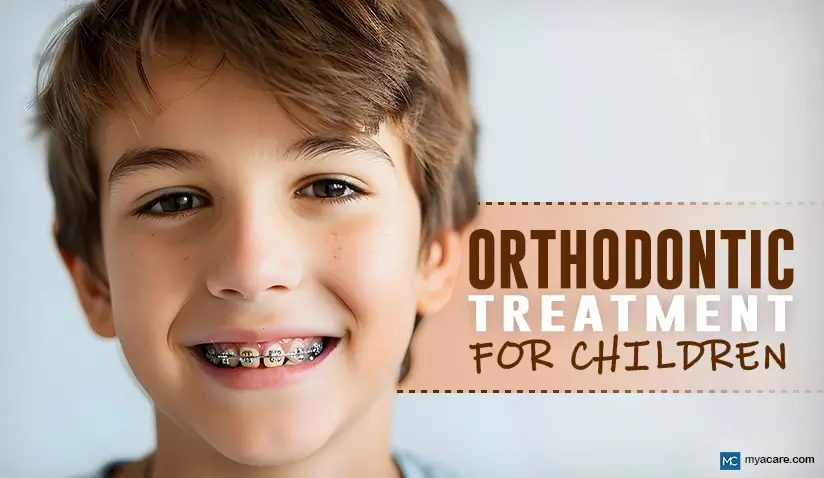Braces Beyond Aesthetics: Reasons for Considering Orthodontic Treatment for Children

The irregularity in the alignment of teeth or the incorrect relationship between the two jaws while closing is known as malocclusion. It is widely prevalent among children and adolescents worldwide, affecting one in two individuals. It can affect appearance, oral functions such as chewing, swallowing, and speaking, and impact psychosocial development. Due to its onset in childhood, early interventions can help prevent and manage the condition. Malocclusion can be corrected with the help of braces, also known as orthodontic treatment.
The average cost of braces in the US is between 3000 USD – 10,000 USD. Meanwhile, the cost of braces in India is INR 35,000 - INR 280,000 (470 USD- 4000 USD). The price may vary based on the type and material of braces preferred for the treatment.
Parents usually seek orthodontic treatment to improve facial aesthetics and boost the self-esteem of the child. However, not many parents are aware of the adverse effects of malocclusion in children. Below are some of the adverse effects of malocclusion that parents should consider before deciding on the orthodontic treatment for their child:
- Decreased chewing efficiency: The presence of malocclusion affects muscle function which in turn decreases the chewing efficiency. Even the presence of crossbites (upper teeth sitting behind the lower teeth when mouth closed) or reduced contacts between the teeth can result in asymmetric muscular activity while chewing and reduction in the biting force. On the other hand, the presence of an open bite (upper and lower teeth do not touch when the mouth is closed) or teeth that do not bite together can make it difficult to cut or chew certain food.
- Temporomandibular joint disorders: The Temporomandibular joint (present in front of ears) aids in functional movements such as opening, closing, and side to side movements of the lower jaw. Researchers believe that the presence of malocclusion (e.g., crossbites, open bite, forwardly placed upper teeth) may have an impact on the health of the temporomandibular joint, causing temporomandibular joint disorders. These symptoms include pain and tenderness in the jaw or joint, facial pain, clicking sound within the joint, and difficulty while chewing. Malocclusion is considered a risk factor for temporomandibular joint disorders.
- Increased incidence of gum diseases and decay: The presence of mal-aligned teeth encourages the retention of plaque (tartar) which is a breeding ground for microorganisms that cause inflammation of gums and tooth decay. Crowding or displacement of teeth and forwardly-placed teeth are associated with gum diseases. Research suggests that straight teeth are easier to clean than crooked ones. Mispositioned teeth requires additional and regular dental hygiene maintenance, which is essential for preventing gum diseases and tooth decay.
- Increased risk of traumatic dental injuries: The presence of forwardly-placed front teeth (increased overjet) increase the risk of trauma to these teeth. Excessively forwardly placed upper front teeth with lip incompetence (inability to seal the lips) are more vulnerable to accidental injuries during sports activities. Research suggests that early orthodontic treatment in children helps reduce traumatic dental injuries.
- Speech-related difficulty: Speech can be affected by malocclusion. Certain sounds such as ‘t’ and ‘d’ are articulated with the tongue touching against the inner surface of upper front teeth. In presence of malocclusion where the tongue fails to achieve contact between the front teeth then it may contribute to lisp in speech.
- Root resorption and cyst formation: The presence of unerupted and impacted teeth especially canines or third molars are common in children and adolescents. Unerupted and impacted teeth may dissolve the roots of adjacent teeth (root resorption) and cause formation of a cyst (fluid-filled cavity). If left untreated, root resorption can cause movement and loss of adjacent teeth. In these cases, orthodontic intervention is recommended to prevent the resorption of adjacent teeth and allow the eruption of the impacted teeth through orthodontic mechanical traction.
What is the best time to undergo orthodontic treatment in children?
Ideally, children should undergo an evaluation for orthodontic treatment at the age of 7 years. Few may require an intervention at this age to guide the growth of jaws or to correct undesired habits (e.g., thumb sucking, abnormal swallowing, lip biting). The right time to undergo orthodontic treatment would be advised by the orthodontist.
What are the benefits of early treatment?
Early treatment has a greater ability to modify skeletal growth in children and regulate the width of jaws, create space for permanent teeth, and correct undesired habits (e.g., thumb sucking, lip biting, abnormal swallowing). The results after the treatment are better and stable. The need for extensive therapy in later stages is greatly reduced along with the potential ill effects of long-standing malocclusion.
To search for the best healthcare providers offering dentistry, please use our search engine. We currently have providers in India, Malaysia, Singapore, Spain, Thailand, Turkey, the UAE, the UK and the United States
To search for the best healthcare providers worldwide, please use the Mya Care search engine.

Dr. Shilpy Bhandari is an experienced dental surgeon, with specialization in periodontics and implantology. She received her graduate and postgraduate education from Rajiv Gandhi University of Health Sciences in India. Besides her private practice, she enjoys writing on medical topics. She is also interested in evidence-based academic writing and has published several articles in international journals.
References:
Featured Blogs



